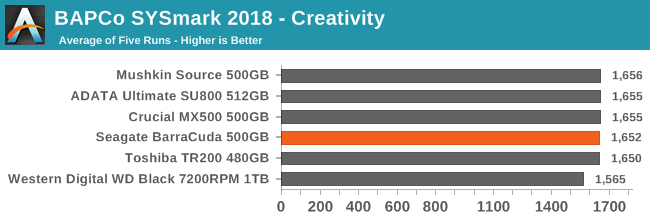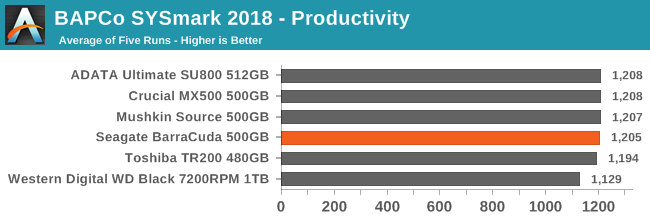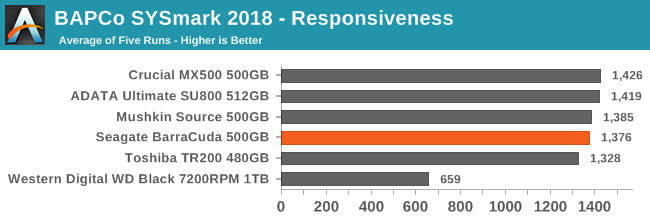The Seagate BarraCuda (500GB) SSD Review: Getting Back In The Game
by Billy Tallis on December 7, 2018 8:00 AM ESTWhole-Drive Fill
This test starts with a freshly-erased drive and fills it with 128kB sequential writes at queue depth 32, recording the write speed for each 1GB segment. This test is not representative of any ordinary client/consumer usage pattern, but it does allow us to observe transitions in the drive's behavior as it fills up. This can allow us to estimate the size of any SLC write cache, and get a sense for how much performance remains on the rare occasions where real-world usage keeps writing data after filling the cache.
 |
|||||||||
The SATA bottleneck renders the SLC caching behavior of the Seagate BarraCuda largely irrelevant for sequential writes. Aside from a momentary blip around the 4GB mark, the BarraCuda stays near the limits of the SATA link for the entire drive filling process.
 |
|||||||||
| Average Throughput for last 16 GB | Overall Average Throughput | ||||||||
The Seagate BarraCuda isn't quite able to match the fastest SATA SSDs for sustained write speed, but it is less than 5% slower. Drives with Silicon Motion's 4-channel SATA SSD controllers have shown that there's no real need for 8-channel controllers in the SATA space anymore, but the 8-channel design of the Phison S10 does convey some fringe benefits as seen here.
BAPCo SYSmark 2018
BAPCo's SYSmark 2018 is an application-based benchmark that uses real-world applications to replay usage patterns of business users, with subscores for productivity, creativity and responsiveness. Scores represnt overall system performance and are calibrated against a reference system that is defined to score 1000 in each of the scenarios. A score of, say, 2000, would imply that the system under test is twice as fast as the reference system.
SYSmark scores are based on total application response time as seen by the user, including not only storage latency but time spent by the processor. This means there's a limit to how much a storage improvement could possibly increase scores, because the SSD is only in use for a small fraction of the total test duration. This is a significant difference from our ATSB tests where only the storage portion of the workload is replicated and disk idle times are cut short to a maximum of 25ms.
| AnandTech SYSmark SSD Testbed | |
| CPU | Intel Core i5-7400 |
| Motherboard | ASUS PRIME Z270-A |
| Chipset | Intel Z270 |
| Memory | 2x 8GB Corsair Vengeance DDR4-2400 CL17 |
| Case | In Win C583 |
| Power Supply | Cooler Master G550M |
| OS | Windows 10 64-bit, version 1803 |
Our SSD testing with SYSmark uses a different test system than the rest of our SSD tests. This machine is set up to measure total system power consumption rather than just the drive's power.



The Seagate BarraCuda provides adequate performance for the CPU and memory-bound Creativity and Productivity scenarios, but on the Responsiveness test it comes up a bit short of what a mainstream SATA SSD should deliver. Instead, it scores more in line with the DRAMless SATA SSDs, which is still far better than a 7200RPM hard drive.
Energy Usage
The SYSmark energy usage scores measure total system power consumption, excluding the display. Our SYSmark test system idles at around 26 W and peaks at over 60 W measured at the wall during the benchmark run. SATA SSDs seldom exceed 5 W and idle at a fraction of a watt, and the SSDs spend most of the test idle. This means the energy usage scores will inevitably be very close. A typical notebook system will tend to be better optimized for power efficiency than this desktop system, so the SSD would account for a much larger portion of the total and the score difference between SSDs would be more noticeable.

The overall system energy usage during SYSmark is reasonably low for the Seagate BarraCuda, indicating that the slightly lower performance of the BarraCuda doesn't add much to the overall runtime of the test. The good active idle power management (see page 9) also contributes to this good score.










39 Comments
View All Comments
takeshi7 - Friday, December 7, 2018 - link
"they bought controller designer SandForce right around when SandForce drives disappeared from the market for good."That's not strictly true. Seagate still use controllers based on SandForce for some of their enterprise SSDs. Look for DuraWrite Technology in their marketing materials to know which ones.
The_Assimilator - Friday, December 7, 2018 - link
SandForce disappeared from the *consumer* market, to be precise. And it was all the more surprising because of how much they shaped the formative years of mainstream SSDs. Reading about the reasons behind that company's implosion in someone's autobiography is going to be interesting.mikato - Friday, December 7, 2018 - link
I would like to know this also. Did the top brains get hired away to somewhere else somehow right when Seagate bought them or what?DanNeely - Friday, December 7, 2018 - link
IIRC Rumor mill at the time was that their next gen controller wasn't competitive and unable to get the design wins they needed they ran out of money and got snapped up on the cheap.Qasar - Friday, December 7, 2018 - link
https://en.wikipedia.org/wiki/SandForceBeaver M. - Wednesday, December 12, 2018 - link
Nothing was surprising. Every expert knew they wouldnt last long with their focus on compressed performance and manufacturers promoting that without criticism.Many customers felt scammed when the controllers never delivered the performance they promised, because the real high numbers were only achievable with compressible content (who the hell has a 5 GB doc file?).
In every forum experts told people not to buy Sandforce SSDs or memory sticks, because of that fact. That sealed their fate.
HighTech4US - Friday, December 7, 2018 - link
Not competitive on price.$84.99 for the 500GB model.
I just purchased on Dec 4th a brand new Intel 545s 2.5" 512GB SATA III 64-Layer 3D NAND Internal Solid State Drive SSD from Newegg for $34.99 (after $20 PayPal coupon)
Death666Angel - Friday, December 7, 2018 - link
"after $20 PayPal coupon" So, Christmas offerings plus another coupon? Great comparison!HighTech4US - Monday, December 10, 2018 - link
So show me where I can get the this 500GB model for $54..99 then. That was what I paid pre-coupon for the 512GB Intel SSD.Like I said Seagate is not competitive on price.
Donkey2008 - Thursday, December 13, 2018 - link
I used a $50 Amazon gift certificate to get my Samsung SSD for $4.99. Seagate will never beat that price.(sarcasm)